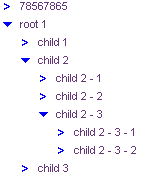Fix for Tomahawk checkbox with disabled SelectItems
Today I will publish a little bugfix for tomahawk <t:checkbox/> issue 1436.
I’m using tomahawk 1.1.7 the current development version is 1.1.9, the issue „t:checkbox disregards disabled property“ is still unresolved.
So here is the solution …
I wrote my own HtmlCheckboxRenderer:
/**
* Fix for issue https://issues.apache.org/jira/browse/TOMAHAWK-1436.
* The renderer should evaluate the "disabled" state for a each {@link SelectItem} too.
*/
public class HtmlCheckboxRendererFix1436 extends HtmlCheckboxRenderer {
@Override
protected void renderSingleCheckbox(final FacesContext facesContext,
final HtmlCheckbox checkbox) throws IOException {
// copied from original
final String forAttr = checkbox.getFor();
if (forAttr == null) {
throw new IllegalStateException("mandatory attribute 'for'");
}
final int index = checkbox.getIndex();
if (index < 0) {
throw new IllegalStateException("positive index must be given");
}
final UIComponent uiComponent = checkbox.findComponent(forAttr);
if (uiComponent == null) {
throw new IllegalStateException("Could not find component '" + forAttr
+ "' (calling findComponent on component '"
+ checkbox.getClientId(facesContext) + "')");
}
if (!(uiComponent instanceof UISelectMany)) {
throw new IllegalStateException("UISelectMany expected");
}
final UISelectMany uiSelectMany = (UISelectMany) uiComponent;
final Converter converter = getConverter(facesContext, uiSelectMany);
final List selectItemList = RendererUtils.getSelectItemList(uiSelectMany);
if (index >= selectItemList.size()) {
throw new IndexOutOfBoundsException("index " + index + " >= " + selectItemList.size());
}
final SelectItem selectItem = (SelectItem) selectItemList.get(index);
final Object itemValue = selectItem.getValue();
final String itemStrValue = getItemStringValue(facesContext, uiSelectMany, converter, itemValue);
final Set lookupSet = RendererUtils.getSelectedValuesAsSet(facesContext, uiComponent, converter, uiSelectMany);
final ResponseWriter writer = facesContext.getResponseWriter();
writer.startElement(HTML.LABEL_ELEM, uiSelectMany);
// FIX 1436 isDisabled should check selectitem too!
// || selectItem.isDisabled()
renderCheckbox(facesContext, uiSelectMany, itemStrValue, selectItem.getLabel(),
isDisabled(facesContext, uiSelectMany) || selectItem.isDisabled(),
lookupSet.contains(itemStrValue), false, index);
// FIX 1436 isDisabled should check selectitem too!
writer.endElement(HTML.LABEL_ELEM);
}
}
and put it in my faces-config.xml:
<render-kit>
<render-kit-id>HTML_BASIC</render-kit-id>
<renderer>
<!-- fixed org.apache.myfaces.renderkit.html.ext.HtmlCheckboxRenderer issue 1436 -->
<component-family>org.apache.myfaces.Checkbox</component-family>
<renderer-type>org.apache.myfaces.Checkbox</renderer-type>
<renderer-class>org.apache.myfaces.renderkit.html.ext.HtmlCheckboxRendererFix1436</renderer-class>
</renderer>
</render-kit>
With this changes the following example will work:
<a4j:form> <t:selectManyCheckbox id="name" layout="spread"> <f:selectItem itemValue="0" itemLabel="foo" itemDisabled="true"/> <f:selectItem itemValue="1" itemLabel="bar" /> <f:selectItem itemValue="2" itemLabel="hustensaft" /> </t:selectManyCheckbox> <h:panelGrid> <t:checkbox for="name" index="0" /> <t:checkbox for="name" index="1" /> <t:checkbox for="name" index="2" /> </h:panelGrid> </a4j:form>
The first checkbox should be disabled:
That’s it 😀




 ) is on the same level with the node-icon (
) is on the same level with the node-icon ( ). That’s very hard to fix this with CSS (it’s possible but i prefer my strange solution ;)). The
). That’s very hard to fix this with CSS (it’s possible but i prefer my strange solution ;)). The 

Antworten
Du musst angemeldet sein, um einen Kommentar abzugeben.